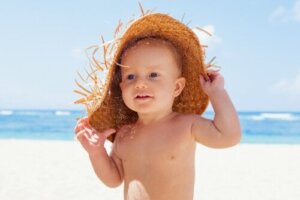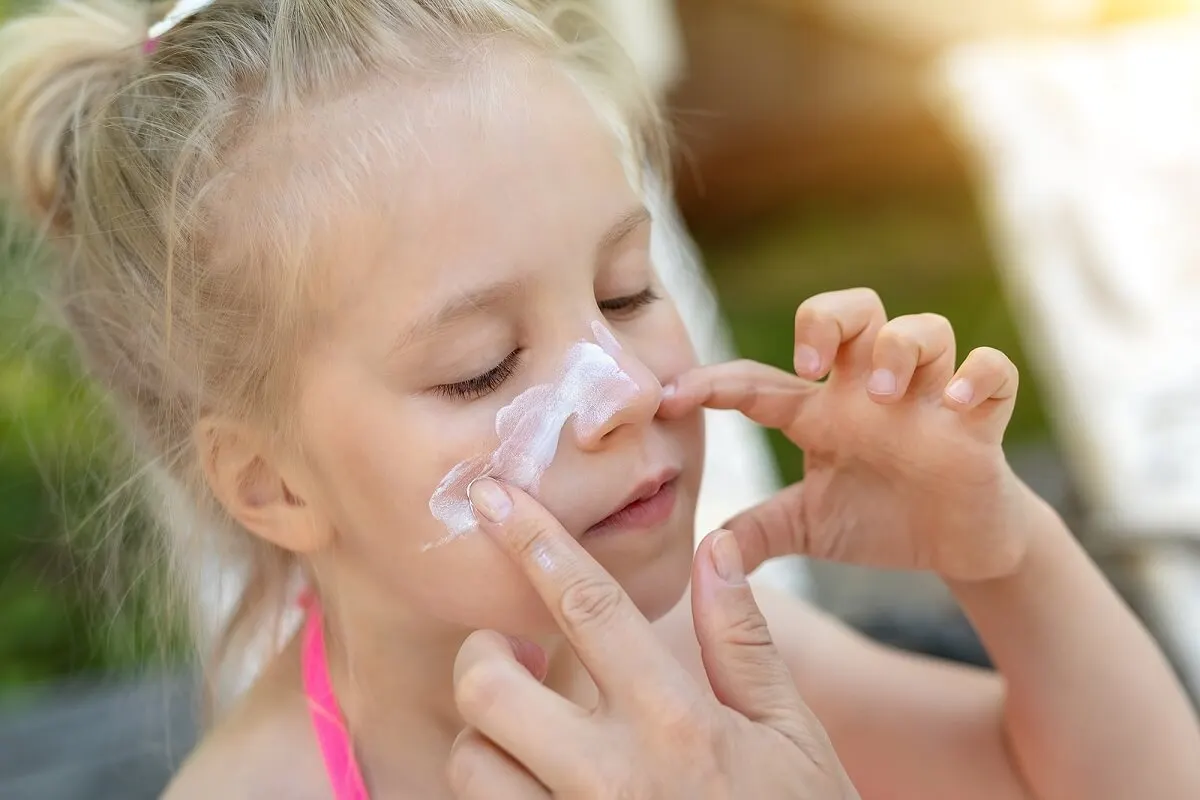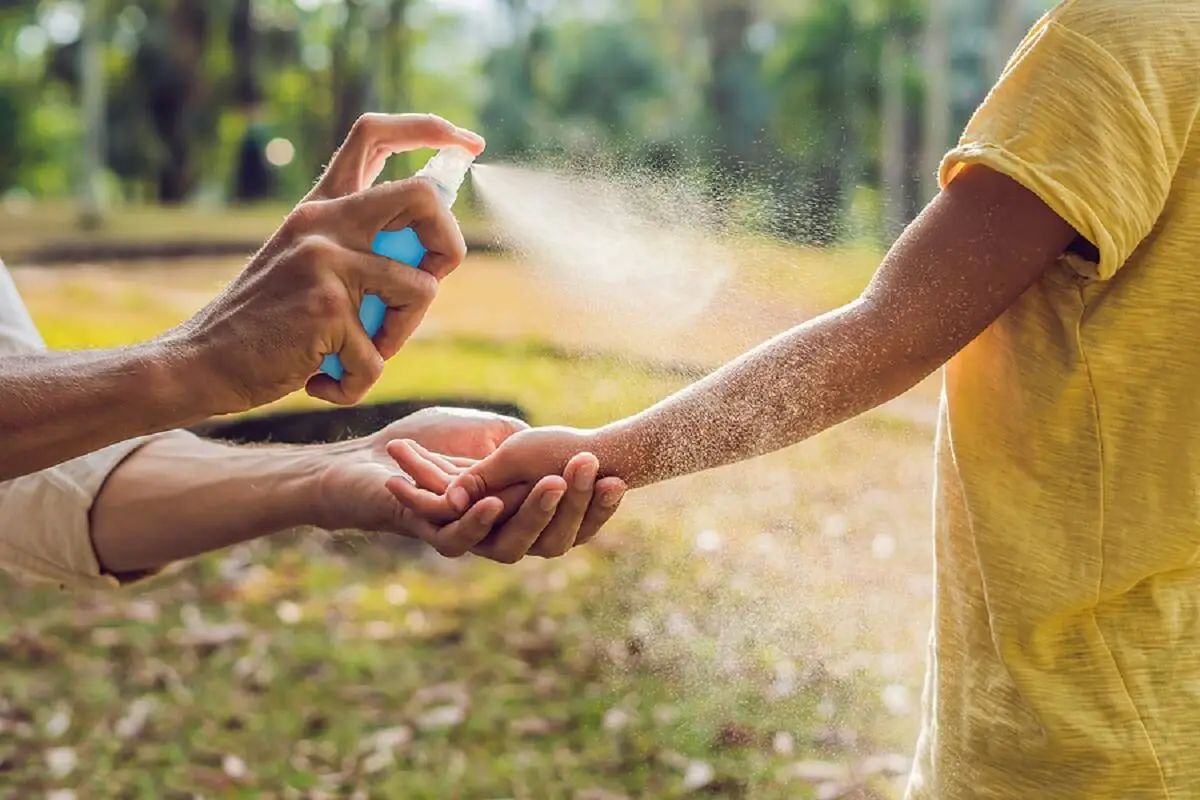Summer Skin Care for Babies and Children


Written and verified by the dermatologist Maria del Carmen Hernandez
Summer skin care for babies and children is very important. Due to their delicate skin, the sun’s UV rays can cause problems if the necessary preventive measures aren’t taken.
As we all know, children tend to be more exposed to the sun at this time of year, since many of the activities they participate in take place outdoors. What can be done to avoid sun damage?
7 tips for summer skin care for babies and children
The summer season is one of the most awaited of the year. However, due to the sudden change in temperature and the many outdoor plans, it’s advisable to take extreme care, especially as far as skin health is concerned. Discover below some recommendations aimed at protecting the skin of babies and children.
1. Sun protection
From 6 months of age, babies can use sunscreen as part of the measures to mitigate solar aggressions. In younger babies, avoiding direct exposure to the sun and keeping them in the shade is the best measure to avoid inconveniences.
Ideally, children should use a sunscreen with a protection factor (SPF) equal to or higher than 50. In addition, it should have a broad protection spectrum, covering UVA and UVB rays.
In addition, it’s advisable to limit the time and amount of sun exposure, as the hours between 12.00 and 16.00 should be avoided. During this period, UV rays are more harmful.
Sunscreens to ensure good summer skin care for babies and children are available in several presentations. Some of them are the following:
- Gels
- Creams
- Aerosols
- Lotions
- Ointments
- Lip balms

It’s also advisable to check the expiration date of the product before applying it. Once opened, it lasts only one year. It should be applied to the ears, face, neck, arms, and any area of the body that isn’t covered by clothing.
If possible, it’s best to use it before sun exposure and repeat its application every 2 hours. In fact, the product should be used even on cloudy days, as UV rays pass through in the same way.
It isn’t advisable to use lotions containing p-aminobenzoic acid (PABA), as this is a frequent cause of allergies and causes permanent stains on clothing. Octylmethoxycinnamate, the UVB protector used for children, doesn’t cause allergies.
You may be interested in: Myths and Interesting Facts about Sunscreen
2. Clothing with sunscreen
During the summer, one of the basic precautions to protect the skin of babies and children is to dress them in clothing that covers any part of the body that may be exposed. Keep in mind that clothing itself doesn’t block UV rays completely. However, it can help to reduce their effects.
However, there are now textile companies that market fabrics with UV protection. They usually have a label indicating the UV protection factor (UPF) value on a scale from 15 to 50+. The higher the UPF, the more protection it provides.
It’s important to remember that babies under 6 months of age shouldn’t have prolonged sun exposure, so the first option is always to seek shade. Of course, their protection should be complemented with physical barriers such as clothing and hats.
3. Insect repellent
The presence of insects shouldn’t be overlooked this summer. However, it’s important to remember that it isn’t advisable to mix repellent with sunscreen.
The correct way is to apply the sunscreen 30 minutes before the repellent. Also, it’s best to avoid the use of perfumes, cosmetics or any substance that has dyes, as they can cause hypersensitivity reactions and irritation.

4. Use of hats
Hats are good complements to mitigate the negative effects of sun exposure. According to an article published in The British Journal of Dermatology, hats with wide brims are the most appropriate. They protect the ears, eyes, nose, forehead and scalp.
These areas are susceptible to damage from solar radiation, although they’re sometimes overlooked. Thus, their use helps to cover more areas of the body and, together with the other measures, decreases the risk of a possible heat stroke.
Read also: Should You Use Sunscreen as a Moisturizer?
5. Baths and hygiene
Hygiene is essential to keep children’s skin barrier healthy. Baths shouldn’t be long, nor should they be with lukewarm water, so as not to cause skin dehydration or worsen eczema and atopic dermatitis, frequent conditions in the first years of life.
A study published in 2016 in Jornal de Pediatría recommends syndet gels and shampoos (without detergents) to avoid irritations. After each bath, a lotion or cream should be applied, since this is when the skin absorbs more of the product.
In summer, it’s essential to rinse children’s skin after going to the beach or swimming pool, to prevent chlorine and saltpetre from drying it out. In addition, it’s advisable to dry them with a clean towel, especially in the folds of the arms and knees, where moisture is retained, which can lead to erythema.
6. Don’t forget to moisturize your little one’s skin well
Sun exposure and long periods in the water during the summer often affect the hydration of babies’ and children’s skin. For this reason, it’s essential to protect our children’s skin with a moisturizing cream, especially if it’s hypoallergenic.
In infants, special attention should be paid to the diaper area. It’s advisable to use a cream that avoids dehydration, isolates rubbing and irritating substances, and promotes skin revitalization. In these cases, provitamin B5 and panthenol are usually recommended.
7. Opt for comfortable diapers
Summer sweat and humidity are frequent risk factors for developing various forms of dermatitis and skin infections. In children, the groin, genitals and buttocks are the most sensitive areas due to diaper use.
It’s advisable to use breathable diapers and change them frequently. In addition, leaving our little ones without diapers every so often is also beneficial.
Special care for newborns in the summer
In general, newborn babies have a more delicate, thinner and fragile skin than older children. They have immature skin defense systems and aren’t able to regulate their body temperature very well.
In this regard, the main factors affecting newborn skin are the sun and heat. Some tips to avoid sunburn and dehydration are as follows:
- Avoid exposing the newborn baby to direct sunlight
- Use a parasol and, if possible, keep the baby in the shade
- Use light linen or cotton clothes to dress them
- Keep the baby in a ventilated and cool environment
- Breastfeed frequently or give water to babies older than 6 months
Sunscreens shouldn’t be used in the first six months of life, as there’s a greater risk of allergic reactions. In case of bathing at the beach or swimming pool, we should bathe the newborn very well with clean, filtered water to remove any sand or chlorine.
Protecting the skin of babies and children in summer is important
Sun exposure during the summer is a very serious issue, especially when it happens to babies and children. It’s advisable to ensure maximum protection, as there’s a high risk of burns and associated complications. In addition, in the future, solar aggressions increase the risk of melanoma.
All cited sources were thoroughly reviewed by our team to ensure their quality, reliability, currency, and validity. The bibliography of this article was considered reliable and of academic or scientific accuracy.
-
Julian E, Palestro AM, Thomas JA. Pediatric Sunscreen and Sun Safety Guidelines. Clin Pediatr (Phila). 2015;54(12):1133-1140.
- Adam J. Sun-protective clothing. J Cutan Med Surg. 1998;3(1):50-53.
- Volkmer B, Greinert R. UV and children’s skin. Prog Biophys Mol Biol. 2011
-
Paller AS, Hawk JL, Honig P, et al. New insights about infant and toddler skin: implications for sun protection. Pediatrics. 2011;128(1):92-102.
- Mendes BR, Shimabukuro DM, Uber M, Abagge KT. Critical assessment of the pH of children’s soap. J Pediatr (Rio J). 2016
-
Kiely AD, Hourihane J. Sun exposure and sun protection practices of children and their parents. Ir Med J. 2009;102(5):139-143.
- Thoonen K, Schneider F, Candel M, de Vries H, van Osch L. Childhood sun safety at different ages: relations between parental sun protection behavior towards their child and children’s own sun protection behavior. BMC Public Health. 2019;19(1):1044.
-
Phillips D, Adams G. Child care and our youngest children. Future Child. 2001;11(1):34-51.
This text is provided for informational purposes only and does not replace consultation with a professional. If in doubt, consult your specialist.








